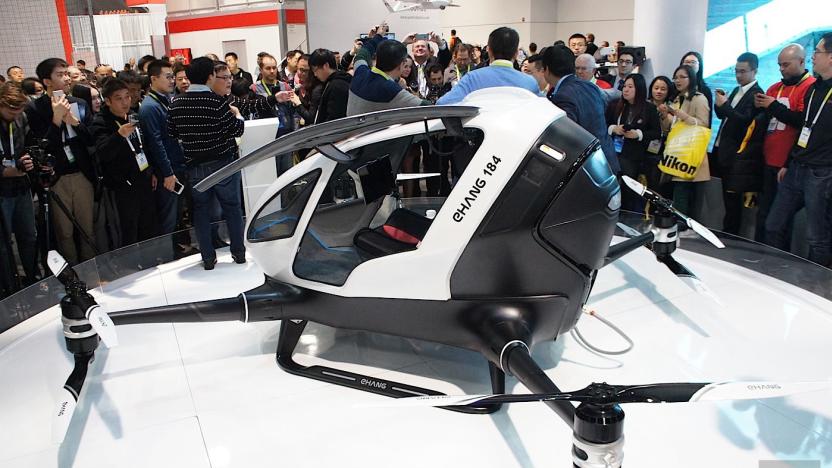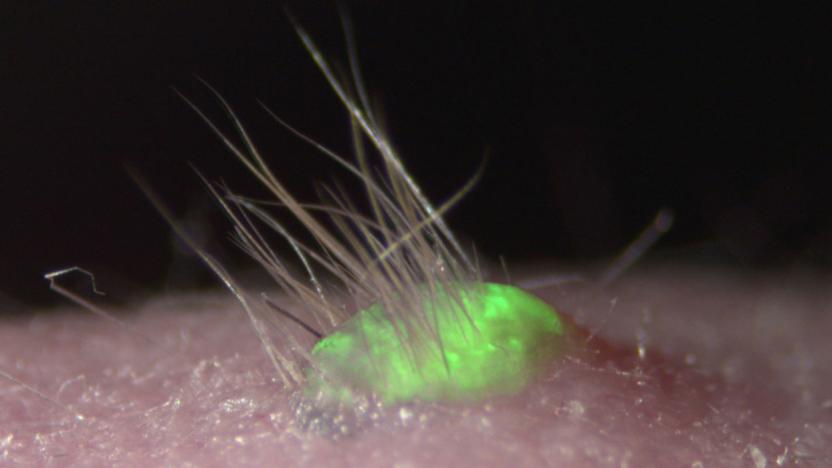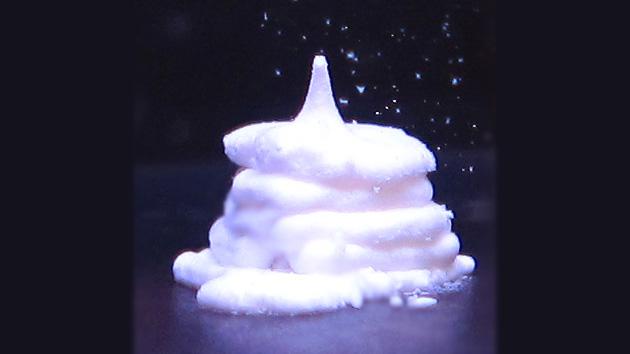transplant
Latest

Biotech firm wants to deliver organs using a passenger drone
Do you remember the EHang "delivery drone for humans" from CES 2016? The company is still around, and has cranked up the level of hype with a new deal. It will develop and produce 1,000 copies of the drone for Lung Biotechnology PBC, a company that wants to manufacture lungs and other artificial organs. The biotech firm plans to station Ehang's drone, which will be re-purposed as the "Manufactured Organ Transport Helicopter (MOTH)," outside its facility. Then, it will transport artificial organs to needy patients at hospitals, according to the news release.

Artificial skin grows hair and sweat glands
You've probably seen artificial skin before, but never has it been quite so... accurate. Japanese researchers have grown skin tissue that not only includes hair follicles, but all the glands that come with it -- including oil and sweat glands. The trick was to take cells from mouse gums, turn them into stem cell-like forms that generate skin, and implant those into mice with immune system deficiencies (which lets the new skin grow unimpeded). The resulting skin was a little creepy -- just look at the wart-like growth above -- but it was healthy, behaved normally and made connections with natural tissue.

The first uterus transplant in the US has failed
Medical progress sometimes doesn't go according to plan. Cleveland Clinic has announced that the first US uterus transplant failed just two weeks after doctors put it in. Details of what went wrong are scarce, but the Clinic says that a "sudden complication" forced the removal. While the 26-year-old patient (referred to only as Lindsey) is recovering well, it's clear that such a groundbreaking procedure isn't easy. Not that the Clinic is giving up -- it's continuing with a transplant study that should include 10 women, and hopes that this transplant will eventually give more women a chance at childbirth.

Cleveland Clinic performs first uterus transplant in the US
Doctors in Cleveland have performed the first successful uterus transplant in the United States. But, once the 26 year-old recipient has one or two babies, the womb will be removed so she can stop taking medications that prevent her body from rejecting the foreign organ -- a very real risk that's haunted the procedure in the past. Her previously impossible pregnancy will rely on in vitro fertilization, using her eggs (harvested prior to the transplant) that've been fertilized with her husband's sperm and then frozen, according to The New York Times.

Tinder wants to talk to you about organ donation
If you're hot and horny then there's one thing that's guaranteed to kill the mood stone dead: a long discussion about organ donation. Tinder isn't too worried about harshing that buzz, which is why it's teamed up with the UK's blood and transplant service to raise awareness about the importance of organ donation. For the next two weeks, users will be able to spot celebrity profiles like Olympic gold medalist Jade Jones as well as TV stars Jamie Laing and Gemma Oaten. If you swipe right on any of the three, you'll be greeted with a notification saying "if only it was that easy for those in need of a life-saving organ to find a match."

The After Math: 'Murica!
With the presidential elections just under a year away, the American political season is kicking into high gear. But the race to be Commander in Chief isn't the only thing going on in this country. We've got veterans getting new members, Chicken McNugget dispensers and hoverboard bans as well! Here's your United States, by the numbers.

America's first penile transplants will be for war veterans
Arms and legs aren't the only appendages that American servicemen lose to IEDs but, thanks to a pioneering surgical technique, injured soldiers will soon have the option of replacing their war-damaged wedding tackle. A team of surgeons from Johns Hopkins University School of Medicine announced on Sunday that within a year (more likely, just a few months) their facility will begin performing penis transplants. American veterans will be their first patients.

Scientists make an artificial heart out of foam
Artificial hearts only kinda-sorta behave like the real thing. They pump blood, sure, but they're typically solid blocks of machinery that are out of place in a squishy human body. Cornell University thinks it can do better, though: its scientists have developed an artificial foam heart that imitates both the functions and shape of its fleshy counterpart. The key is a new polymer that can be poured into specific shapes, and has pores that let it pump fluids. It's not only soft and stretchable, but more efficient -- you don't need much energy to get liquids moving.

Monkeys may be the first primates to get successful head transplants
Outside of horror and sci-fi flicks, head transplants aren't really viable. What attempts have been made so far usually kill the unfortunate test subjects within a day, and they can't really survive without life support. Researchers at China's Harbin Medical University think they can do better, however. In the wake of hundreds of mouse operations, the scientists are planning to conduct the first primate head transplants where the patient survives on its own for at least a while. The surgery will connect only a fraction of the spinal nerve fibers in the long-tailed macaque monkeys going under the knife, but it should be enough to maintain voluntary muscle movement and other crucial functions.

Scientists are one step closer to growing replacement limbs
If the goal in medicine is to be able to repair people as if they were made out of Lego, then we just took a big stride towards that future. A team at Massachusetts General Hospital has managed to grow a rat's forearm that, theoretically, could open the door to whole-limb transplants. The team, led by organ regeneration expert Harold Ott used a technique called decel/recel, which has already been used to grow hearts, lungs and kidneys within the confines of a petri dish.

Artificial blood vessels can cause your body to regrow the real thing
A blocked blood vessel can be pretty nasty, and the two most common treatments involve wedging it open or transplanting another vessel from elsewhere in your body. Scientists in Vienna think they may have a slightly more elegant solution to the latter, having developed a method of replacing blocked vessels with artificial ones. The clever part here is that the synthetic polymer that the prostheses are made of encourages the body to grow a real vessel in its place. In one trial on a rat, it took less than six months before the artificial material had broken down and been replaced with a brand new blood vessel.

Genetic 'glue' helps make 3D-printed organs
No, you're not looking at a dessert gone horribly wrong -- that might just be the future of synthetic organ transplants. Scientists at the University of Texas at Austin have developed a genetic "glue" that forms gels useful for 3D printing organic tissues. The key is using custom-designed, complementary DNA strands that bond just the way you'd like them. This flexibility would let hospitals and labs create organs that grow in a specific way, and take on specific structures. In short, it'd be relatively easy to print the exact organ you need, and even customize it for the recipient if necessary.

3D-printed livers go on sale to impatient scientists
So far, the biggest benefit of 3D-printing organs is that you don't need someone to donate their body to medical science before you can do an experiment. That's why Organovo's big news is so exciting for scientists, since the company has let it be known that its 3D-printed livers are now on sale. The bio-printed tissues can be used for drug testing programs, since causing unexpected liver damage is one of the biggest causes for pharmaceutical recalls. Unfortunately, with a rated lifespan of around 42 days, we won't be able to use these stamp-sized organs in transplants just yet, but who knows? Maybe in a few years time, the idea of asking a relative or close friend for a slice of their liver will be as outdated as sending them a fax.

Scientists grow whole organs inside animals for the first time
Researchers have had success growing organs in controlled lab environments, but repeating that feat inside a complex, messy animal body? That's more than a little tricky. However, researchers at the University of Edinburgh have managed that daunting feat for the first time. They've grown thymus glands inside lab mice by "reprogramming" the genes in tissue-regenerating cells and partnering those with support cells. The team didn't have to use scaffolds or other "cheats" to trigger the growth; it just injected the cells and waited. There weren't even any obvious limitations. The organs were full size (unlike the baby-like results from some experiments), and they were just as efficient at producing virus-fighting T-cells as the real deal.

Regenerative medicine pioneer continues changing lives with first successful laryngotracheal implants
Dr. Paolo Macchiarini is no stranger to world firsts, and less than a year after performing a synthetic windpipe transplant, the Karolinska Institute Professor has coordinated no less than two successful transplants of synthetic sections of larynx. Amazingly, both patients were able to breathe and talk normally straight after surgery, the basic functions we take for granted that they either struggled with or were simply unable to do before. The implants consisted of personally designed synthetic scaffolds coated with the candidates' own stem cells, so there's neither the chance of rejection nor the burden of life-long immunosuppressant therapy. Despite the amazing feat, Dr. Macchiarini ain't done yet, claiming this is the first of many steps towards building a synthetic, complete larynx -- voice box and all. Jump past the break for the official PR issued by Harvard Bioscience, the company responsible for growing what's in that tub.

First full-face transplant completed in France: tear ducts, eyelids, and all
While the idea of transplanting an entire face from a corpse -- including the eyelids, tear ducts, and mouth -- might seem, well, gross, you probably don't suffer from a face deforming genetic disorder. For the 35-year-old patient "Jerome," it's a technical miracle. The successful operation, carried out by Laurent Lantieri, is a claimed world's first and was completed just a few weeks ago at the Creteil Henri-Mondor hospital outside of Paris. According to local newspaper reports, the patient, who had been waiting two years for the surgery, gave an enthusiastic "thumbs up" when he first saw his new face in the mirror. Naturally, the operation also reconnects nerves and blood vessels using a microscope -- in fact, the patient's beard has even started to grow in. God complex, deserved, Dr. Lantieri. P.S. That image above is not from the surgery. We said it was performed France, not Brazil.

Methodist University Hospital confirms Steve's liver transplant
Late last week, the Wall Street Journal reported that Steve Jobs had a liver transplant in April. As of this morning, however, we still hadn't received confirmation from either Apple or any of the hospitals at which the procedure might have been performed. That's changed. Earlier today, Methodist University Hospital in Memphis released a statement confirming the surgery, with Steve's permission: "I am pleased to confirm today, with the patient's permission, that Steve Jobs received a liver transplant at Methodist University Hospital Transplant Institute in partnership with the University of Tennessee in Memphis ... Our one-year patient and graft survival rates are among the best in the nation and were a dominant reason in Mr. Jobs's choice of transplant centers." James D. Eason, M.D., Program Director at Methodist University Hospital's Transplant Institute, composed the statement and explained that Steve went through the typical transplant eligibility process; in order to receive a donor liver, he had to be the sickest person on the list when the matching organ became available. This statement stands in contrast to the theories considered in today's New York Times piece about Steve's surgery, which noted that past preferential treatment for celebrities and wealthy patients has largely been ended but there are still ways in which someone with Jobs's resources could try to game the system. The Memphis transplant center has one of the shortest waiting periods in the US for liver patients. Let us extend a "Well done" to the medical team and "Speedy recovery" to Steve.

E911 actually works, finds transplant patient at jazz festival
From listening to your phone calls to reading your text messages, Big Brother will always find a way to keep up to date with our lives. For a 10 year old boy from Pennsylvania who was waiting for a heart transplant, it was an indispensable technology that saved his life. While waiting for a phone call notifying him a donor had been found, they boy was out with his family and unreachable. Luckily for him, his mother had a Sprint celly and the authorities where able to locate them while at a local jazz festival using the phones integrated GPS. Soon after being located, the boy was rushed to Children's Hospital in Pittsburgh where the surgery was a success.






